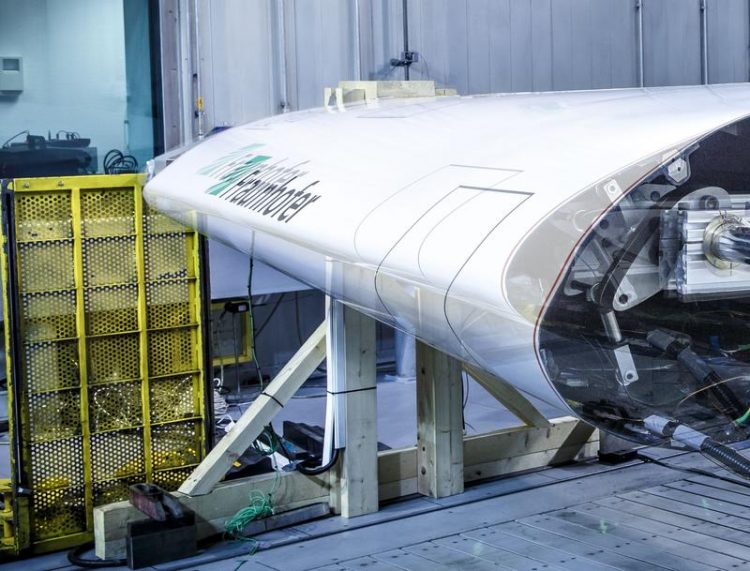Future of aircraft wings: movable leading edge with flexible skin and integrated functions

Droop nose demonstrator with movable leading edge and integrated trendsetting technologies. Photo: Fraunhofer LBF, Darmstadt, Germany
The 1:1 droop nose demonstrator was designed and manufactured at Fraunhofer Institute for Structural Durability and System Reliability LBF in Darmstadt and subsequently tested in a climatic wind tunnel under icing conditions. Based on aerodynamic and aero acoustic specifications, the scientists developed kinematics for deflecting the nose of the wing’s leading edge.
The special feature of this high-lift device in the leading edge region is that it prevents gaps because the skin deforms with it. This is particularly important for future laminar wings as they can only be realized with smooth surfaces. Another expected advantage is reduced noise emissions during landing approach thanks to the lack of gaps. The extensive morphing of the skin, however, which occurs during every operation, necessitates adequate environmental loads performance and structural durability of the system.
An electromechanical actuator causes the skin to deform. In addition, the droop nose also uses several smart memory alloy actuators tested by Fraunhofer IBP. Fraunhofer LBF is developing a process for reconstructing the wing geometry based on sensor signals so that in the future it will be possible to enhance flight kinematics control, as well as proactively avoid forced misalignment, etc.
“Among other sensors, almost 50 fibre-optical strain sensors were integrated in the skin of the movable leading edge for this purpose, and routed to the outside via a newly developed, structurally integrated connector concept. The deep draft, extended conical composite nose design has offered relevant exploration settings in building to function”, explains Martin Lehmann, Fraunhofer LBF.
“Fraunhofer is also thinking to more (vehicle) usage liaised manufacture to be captured and tolerances self-sufficiently upheld, therefore departing somewhat from costly managed jig and correlated flight points design. We want more manufactured-in service and user benefit”, points out John Simpson, Fraunhofer Aviation.
Fraunhofer ENAS provided synthetic jet actuators for the “Wing” technology platform. These are able to exert a positive effect on the airstream. For the first time, Fraunhofer LBF additionally integrated a thermal ice protection system in a highly strained wing leading edge. The extensive deformation of the skin previously made it impossible to solve this design concept satisfactorily.
During the Clean Sky project, Fraunhofer LBF was able to develop a flexible heating system based on carbon nano tubes (CNT). Thermal sensors integrated in the model regulate the temperature. During initial testing of the model, there was good conformity in the wing deformations between the results of the FE simulations and the manufactured model.
The structure and the various technologies functioned well as expected, and Fraunhofer LBF was able to demonstrate the technology’s maturity level as a result of successful mechanical tests and environmental wind tunnel practice. Moreover the forced deformation supports ice-protection – a new pragmatic tested solution.
This new technology is the result of a large-scale research program part, dedicated to regional aircraft. The technology potential is not yet at an end and the plan is to continue activities in future projects. Fraunhofer sees the potential especially in distilling a lower mechanical and electrical energy balance while respecting the reliability of the system. Furthermore, application studies shall provide operational specification fundamentals for the next generation commercial exploitation. A global goal is the servicing of partners from the fields of manufacture to aero servo-elasticity.
http://www.lbf.fraunhofer.de/content/dam/lbf/de/documents/presse/Fraunhofer%20LB…
Media Contact
All latest news from the category: Power and Electrical Engineering
This topic covers issues related to energy generation, conversion, transportation and consumption and how the industry is addressing the challenge of energy efficiency in general.
innovations-report provides in-depth and informative reports and articles on subjects ranging from wind energy, fuel cell technology, solar energy, geothermal energy, petroleum, gas, nuclear engineering, alternative energy and energy efficiency to fusion, hydrogen and superconductor technologies.
Newest articles

First-of-its-kind study uses remote sensing to monitor plastic debris in rivers and lakes
Remote sensing creates a cost-effective solution to monitoring plastic pollution. A first-of-its-kind study from researchers at the University of Minnesota Twin Cities shows how remote sensing can help monitor and…

Laser-based artificial neuron mimics nerve cell functions at lightning speed
With a processing speed a billion times faster than nature, chip-based laser neuron could help advance AI tasks such as pattern recognition and sequence prediction. Researchers have developed a laser-based…

Optimising the processing of plastic waste
Just one look in the yellow bin reveals a colourful jumble of different types of plastic. However, the purer and more uniform plastic waste is, the easier it is to…



